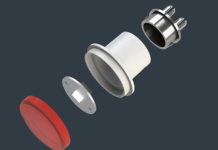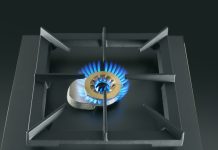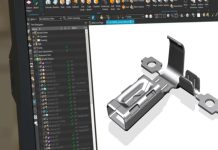Design dimensions have been enriched by several aspects, from design for manufacturing and assembling to design for disassembling, while marketing considerations play a more and more determinant role in designers’ choices.

Roberto Papeschi
One of the main fronts in which is played companies’ competitiveness is constituted by the innovation management, especially in the current historical phase in which the market widening makes more complex the definition of the products that are expected to satisfy a greater variety of consumers’ needs and life styles, while at the same time the life cycle of products is diminishing and the offer quantity on the market is simultaneously increasing.
All that is completed by the new conditions that product designers must take into account, by regulatory binds of the various geographical marketing areas to the increasingly restrictive directives concerning noxious materials, energy saving and environment protection, non only regarding the manufacturing of products and their consumptions under operating conditions but also referred to the service life end and the material recycling.
It we consider then the competence level required to designers and the constraints regarding the scarcity of the human and financial resources at disposal of enterprises, while owing to the “time to market” the product development times get shorter, it is easy to understand how only the adoption of particular approaches and of forefront managerial techniques, able to increase significantly designers’ productivity, allows companies to withstand successfully the competitive effort to which they are subjected.
In particular, it becomes necessary to develop the potential synergies existing among different projects, passing from an “individual-process” management to a “multi-process” management. Besides, we must reap the fruits of the relationships among different knowledge in functional, market and technical terms, concerning products, production processes and disposal procedures at the life end.
In other words, the balance between requirements and resources, which we do not succeed in obtaining on each single project, can be found by widening the horizons of interventions and pooling the biggest possible number of relations existing among them. This raises the design difficulty but at the same time it increases the added value of the product. This is the target set by businesses when developing projects according to the approach of the “technological product platforms”.

Product platforms
Product platforms are one of the multi-process methodologies more diffused today in the project management in numerous industrial sectors, first of all the automotive industry, which in the manufacturing field has constantly anticipated the evolutionary trends by some years. It is in fact just from the automotive sector that derives the “platform” term, used to indicate the car flatbed that constitutes the base component of a vehicle structure on which the whole product architecture is articulated.
The household appliance industry has followed this same approach, even if with the differences that derive from its product typology, whose market value is inferior by one magnitude order to the automotive one. In the household appliance industry, the product platform is constituted by a design structure that allows sharing not only a whole of process technologies but also the biggest possible number of subsystems and components, permitting at the same time the production of differentiated product solutions, able to satisfy the requirements of single markets and of specific categories of buyers. In these terms, the platform can be conceived according to a reduced approach, in which the purely technical aspects of the product are privileged, starting from the base structure up to including then the main components and subsystems of more product families.
According to this vision, the product platform is based on three main elements: the modular architecture, the interfaces between modules and regulatory and functional standards that inspire the product design rules. It is also worth considering how the platform, which in its first automotive definition had a prevailingly mechanical structure, in its turn concerned by the binds of the great mechanization (presses and dies), in a more topical vision must include also an electronic dimension, of which the related hardware and software components are part.
It is however increasingly frequent that the most advanced companies consider the product platform in even more extended sense. According to this second approach, which can be considered strategic and cultural, in a platform project enterprises research the sharing of the widest possible quantity of available resources and processes, including not only the technological structure of the product and the related subsystems and components, but also knowledge, business competences and relationships, together with the productive and distributive processes that they intend to use.

The difficult balance between opportunities and constraints
The biggest advantage that we can achieve with the definition of a technological platform consists in the reduction of the industrial product cost, thanks to the standardization of components and of productive processes. In particular, the major saving is obtained in the purchase cost of raw materials and of components, which in a household appliance represent about 80% of the industrial cost.
The major purchase volumes of the components included in the platform determine in fact a higher contractual power of the enterprise towards suppliers and allow a simplification of the material management operations, an improvement of the lead time and a reduction of stocking costs. Further benefits are then attained in the product transformation costs, from labour costs to fixed production costs through the scale economies permitted by the standardization. At the same time, the product modularity allows simplifying the productive process, also improving the production flexibility in relation to the assembly phases of differentiated product versions.
Besides these immediate benefits, the platform is characterized by longer industrial life in comparison with a single product’s, also because it is generally possible to intervene on it with limited upgrading actions, with the result of including “derived products” into the so modified platform, able to satisfy new market requirements as well as new opportunities deriving from the technological evolution. It is also worth noticing that the eventual maintenance interventions of the platform are characterized by reduced times and costs in comparison with the traditionally necessary ones for the definition of new products.

The introduction of a product platform involves, however, a series of constraints that must be attentively evaluated in the design phase of the system, since they can objectively reduce its flexibility. The platform flexibility, in fact, derives from the modalities with which the product structure has been studied and from the balance resulting between the part standardization and the possibility of differentiating the production with derived models. The higher is the search for common elements, and then standardization, the lower will be in fact the possible variability of products inside the same platform, with negative repercussions on the enterprise’s capability of seizing market opportunities.
On the contrary, an intelligent definition of the modular platform structure, which pools the technological basic elements of the product, permitting however a high variety perceivable through the assembly of differentiating elements, results in the increase of the production flexibility, both in static sense (simultaneous satisfaction of the needs of different consumer categories) and in dynamic sense (compliance of the platform in time, dealing with the technological and market evolution).
It is therefore evident how a strategy oriented to product platforms allows improving the business competitiveness, with a notable saving of human and financial resources. Besides, it allows meeting faster the variable market requirements with a broad product mix, derived starting from a “founder product”, but anyway compatible with the binds that the platform structure implies.
An optimal ratio among the constrains introduced into the product design and the benefits obtained in terms of implementation times of new projects, of component standardization and of material provisioning constitutes a strategic target for business managers, who in this case must attentively use not only their own technological competences but also marketing skills, in a challenge that involves the whole business culture.

The design for manufacturing and assembling
At the beginning of the industrial revolution there was a neat separation between design and production, since the activities of the first autonomously proceeded until the definition of products, whose designs and related material lists were then passed to the factory departments for their production. But during the XX century, with three successive steps, the production organization undergoes a deep transformation.
The change start was determined by Taylor, who at the beginning of the twentieth century introduced the first rationalization elements in the assembly operations, developing that theory of “Times and methods” that for the whole last century was the guideline of the organizers of factory activities, structured with Ford according to the model of the “assembly line”. This model was then surpassed with the “Toyota System”, developed for the Japanese car industry by Sakichi Toyoda, Kiichiro Toyoda and Taiichi Ohno in the years included between 1948 and 1975.
The Toyota System exceeded the Taylorist paradigm of the mass production, introducing the principles of the simplification of productive processes, of the “zero defect” quality, of machining operations with fast equipment changeovers and “just in time” material provisioning, thus paving the way to what was successively called “streamlined production”.
The principles of the Toyota production, in fact, once disclosed in Western nations starting from the half of the Seventies, were rapidly adopted by the manufacturing industries worldwide. Starting from this same basis, in the United States they gave birth to a series of studies whose result was DFMA, that’s to say the “Design For Manufacture and Assembly”. DFMA has added the engineering analysis of machining processes and of assembly operations to the paradigms of Toyota System, in order to obtain the best level of productive efficiency.
Two production methodologies converge in fact into DFMA, the first of which is DFM, or Design for Manufacture, which operates upstream the productive flow and is focused on the production of the parts to be assembled. In its urn, more downstream, operates the DFA, or Design for Assembly, which analyzes the best conditions for an effective assembly. Among the main rules to be observed to optimize the productive efficiency and to reduce machining times and wastes, it is worth reminding the following general principles:
-to make use of a structured list of components,
-to eliminate all possible error sources,
-to reduce drastically the number of single parts to be assembled,
-to favour the integration of more parts in a single complex component,
-to make use of formed instead of assembled components
-to prearrange an easy part identification,
-to provide for an obliged orientation of the parts to be assembled,
-to eliminate the fixings of parts through screws and nails,
-to use fastening systems of the parts by interlocking.

The design for disassembling
At the beginning of this century industry had to face a new challenge due to the growing impact of environmental products and the shortage of resources, consisting both of energy and of materials. In that context, the activity of reuse, recycling and recovery of materials at the end of the product life cycle has become of strategic importance, involving the product design itself. The separation of the assembled parts, in fact, is a necessary operation to allow the recycling of subassemblies, of components and of materials, but to be executed cheaply it needs the compliance with some rules, already in product design phase.
In particular, the reuse of components and of subassemblies requires that their separation can be carried out in non-destructive way, while this is not necessary for the recycling of materials, for which it is however mandatory the possibility of an easy separation of the base elements according to their homogeneous, chemical or metallurgical composition. It is finally worth considering that the parts containing toxic or anyway dangerous materials, like the batteries and the circuits containing refrigerating fluids or mineral oils, must be treated in controlled way during the disposal process, to avoid damages to people or the possible pollution of the environment. Designers should anyway bear in mind some basic rules, to simplify, at life end, the recycling operations of materials:
-To use a minimum number of different materials
-To use codes or symbols that allow the immediate identification of materials
-Not to mix materials that cannot be successively separated
-To assemble different materials with easily removable connection systems
-To make use of connectors instead of welded wirings
-To prefer the use of removable fastenings to the use of adhesives and glues
Concerning the separation of materials, it can be obtained in two ways: by disassembling, proceeding in inverse way in comparison with the assembly operations in the factory or through the product destruction. The disassembling generally constitutes a preliminary operation of recycling processes, aimed both at the recovery of some particular components and at the separation of materials into homogeneous categories, in order to increase the reuse value, before proceeding to the product destruction.
This generally occurs through grinding in special mills, afterwards it is executed the separation of materials, reduced to small sizes, selecting them according to their properties. For these reasons we adopt different methods that use the magnetic properties of ferrous materials or the weight differences among various materials. Another system, developed more recently, consists in melting the ground product into acid solutions, from which to extract the single materials by means of chemical selective processes.

The Indesit Company case
In the household appliance industry, one of the first sector companies paying utmost attention to the product platform issue is Indesit Company. This commitment is witnessed by the interesting study carried out in the ambit of the research project “Innovation as competitive advantage: the household appliance case” of which is Scientific Coordinator the professor Sergio Silvestrelli of the Marche Polytechnics University.
The results of the study were presented in a publication by Federica Pascucci, Research Doctor in Business Economics and Management and professor of the same University. The examined case refers to the implementation in the 2000 year, by Indesit Company, of a “platform” of the washing machine product in the front loading version, called LVB2000, whose founder product was the washing machine Margherita2000.

This platform, which had been developed not only with a technological approach but also extended to marketing and organizational considerations, has deeply innovated the product, also calling for a significant re-engineering of the productive system. The platform was then upgraded from 2001 to 2003 with two successive versions, respectively called “EVO I” and “EVO II”, where they introduced some modifications concerning the electronic part, the graphic interface, the porthole and design parts, as well as mechanical components of the oscillating group and of the hydraulic circuit.
The advantages of the solution studied by Indesit Company mainly consist in the reduction of the industrial cost of the product that to standardization processes that essentially influence the following aspects:
-Reduction of the purchase cost of raw materials and components as a consequence of the bigger purchase volumes
-Reduction of the machining cost of the in-house manufactured parts, due to technological economies that derive from bigger production volumes
-Simplification of the productive process, especially in the assembly phase, thanks to the modularity criteria introduced with the product platform
-Reduction of costs for the management of the product diversity and improvement of the production mix, achievable in the final part of the productive process through the use of design parts and software components
-General improvement in the management of the productive resources and of the material flow, especially concerning the internal logistics
-Development of a “platform project” that has longer service life in comparison with a single product model, allowing periodical maintenance interventions depending on the evolution of technologies and markets
-Minor adaptation interventions in time on production processes




